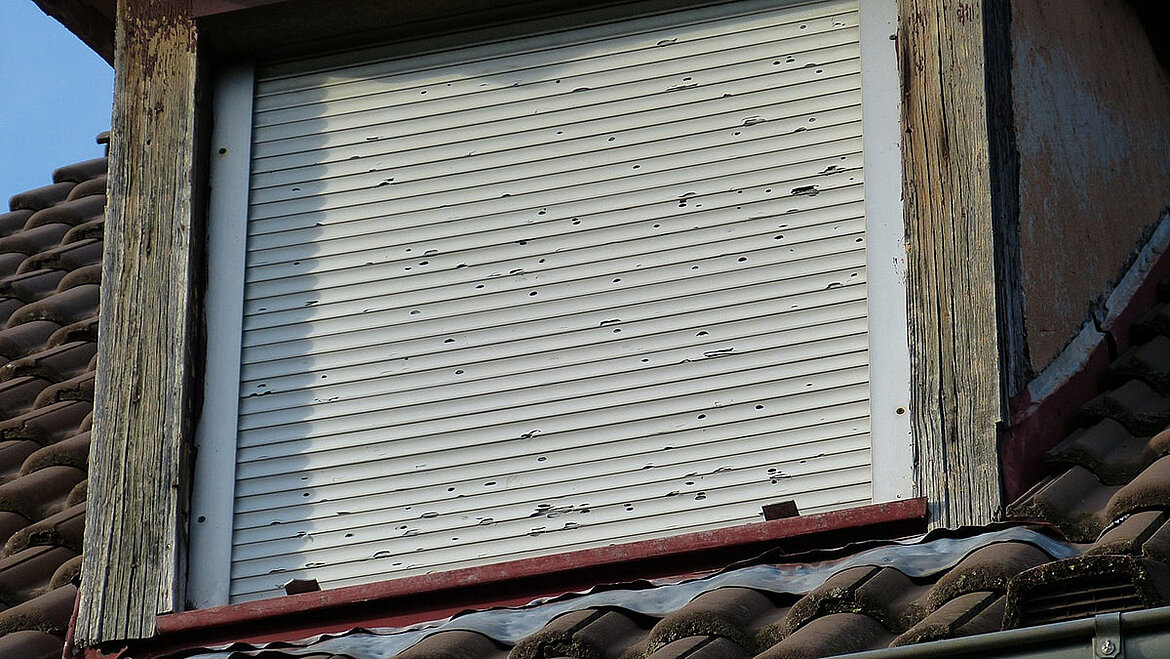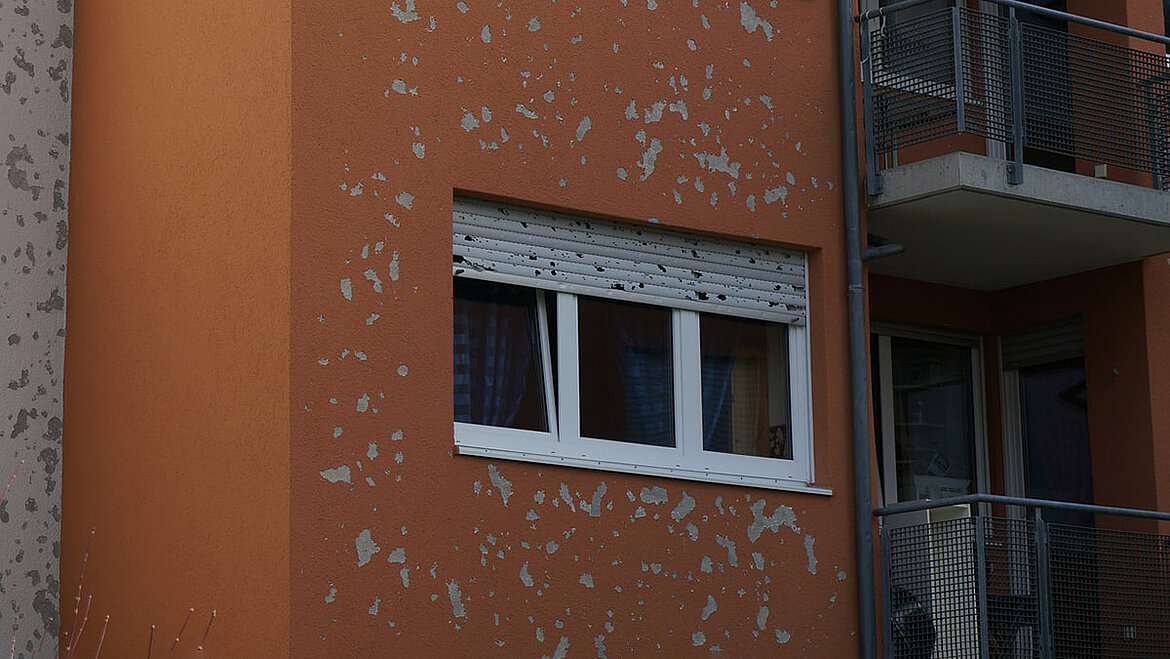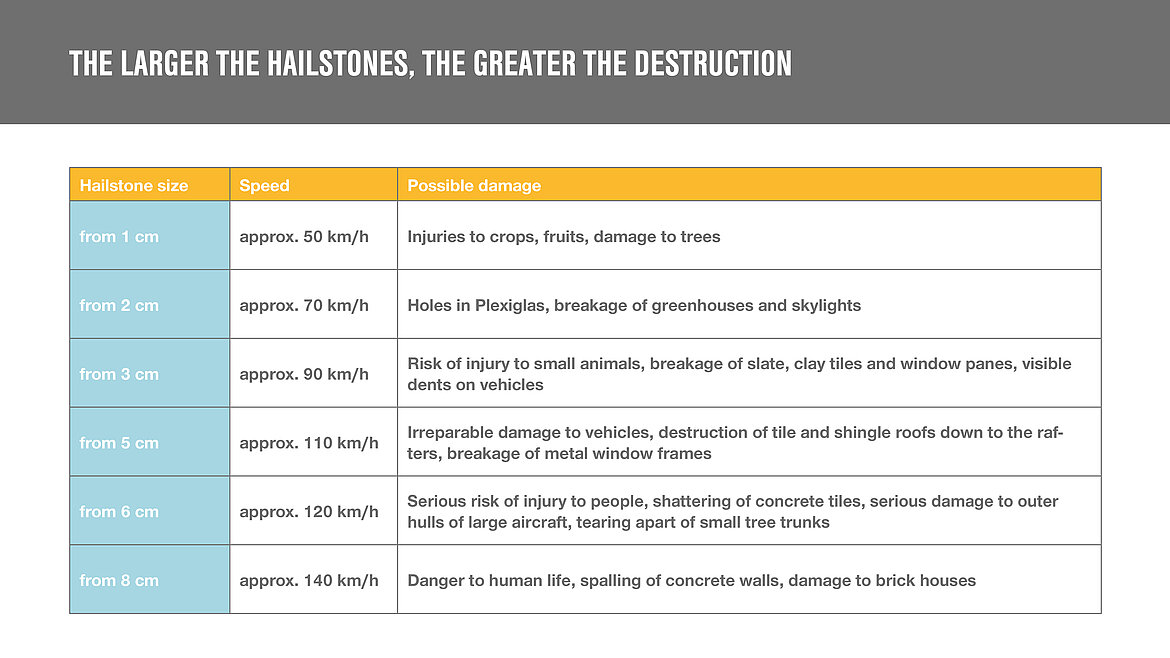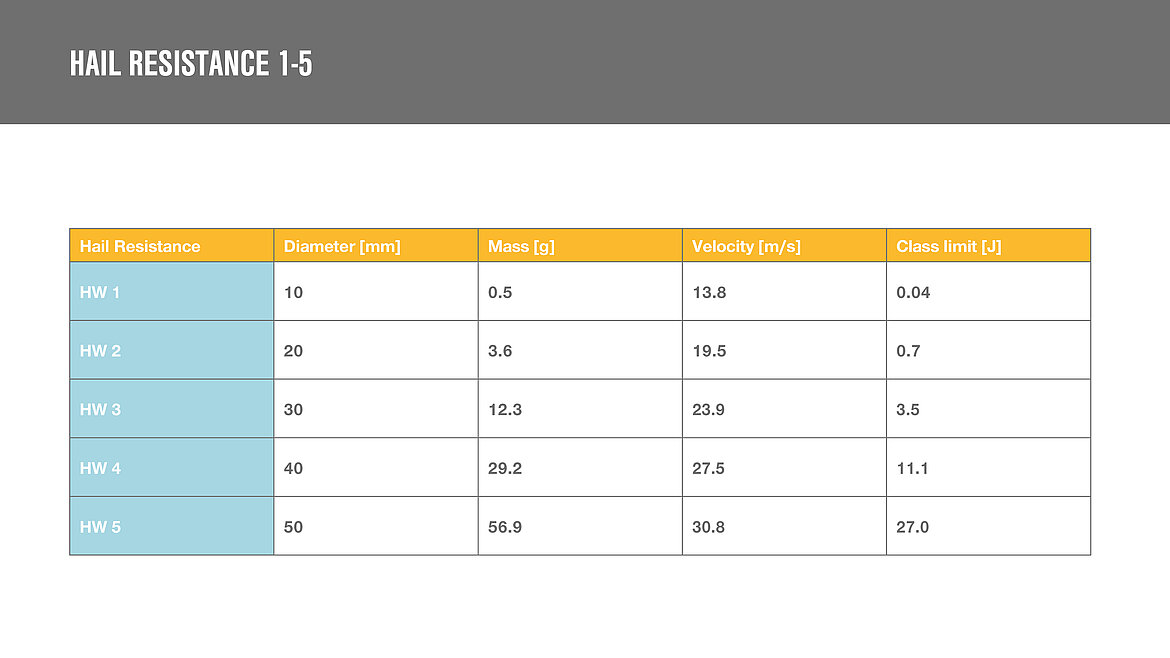Hail protection for skylights
In addition to roof tiles, façades and roofs, hailstones also damage roller shutters and skylights. Hardly any natural event occurs so quickly and has such a devastating effect as hailstorms. The larger and faster the hailstones hit the roofs of buildings, the greater the danger to people and the resulting damage. Skylights, such as rooflight domes and flat roof windows, are predestined for damage from extreme hail due to their location on the roof. Therefore, experts advise taking preventive measures to minimise potential damage from hail events in the future. In this context, it is recommended that components and building materials that are particularly resistant to hail be used.
What is hail and how does it form?

The German Weather Service (DWD) defines hail as precipitation in the form of ice balls or ice lumps. These usually have a diameter of 5 to 50 mm; in extreme incidents even over 100 mm.
Hailstones form in thunderclouds and occur when prevailing ice crystals and supercooled water combine through a collision. The whirled-up ice crystals are shot up by strong winds and freeze into small hailstones. From altitudes of around 12,000 metres, however, the intensity of the wind decreases and the ice drops move downwards again. On the way down, the ice drops combine with other raindrops and their size increases. The resulting hailstones grow by moving up and down in the cloud several times.
If the hailstones are then too large and heavy, they fall from the cloud to the earth. The force with which they arrive at the earth depends on the size and mass of the hailstones. Consequently, the damage they can cause is smaller or greater.
According to the Hagelregister, the risk of hail is most likely with high humidity. Hail formation is also favoured when the air near the ground heats up very quickly.
Hazards due to hail
The size of the hailstones determines the damage to buildings and components in the event of hail. Hailstones cause considerable damage within a very short time: As fast as an ICE train – at up to 150 km/h – the grains hurtle towards the earth, endangering humans and animals. Buildings, agricultural land and fruit trees are mostly affected to the same extent. Hail usually destroys the environment fatally. People and animals can be fatally or seriously injured as a result.
Particularly hard-hit regions
Some areas are particularly affected due to their geographical location. Hail is particularly common in Switzerland and Austria. In Germany, too, hail is causing more and more damage.
In 2019, it hailed around Whitsun, first in Munich, then in the Harz mountains and later in the Erzgebirge mountains for three days. Thousands of cars were damaged during this storm. Buildings and window panes were broken by the hailstones, some of which were up to six and a half centimetres in size. In the south and east of Germany, property damage amounted to approximately 260 million euros – making this storm one of the ten strongest hailstorms since 1997. The worst case of hail occurred in 2013. In Germany, a hailstone measuring 14.1 centimetres was found in the Swabian Alps at the time. The total insured property damage from this storm amounts to more than 3 billion euros.
According to the Natural Hazards Report 2020, the state of Bavaria is particularly affected by hail. Here, hail damage amounting to 675 million euros was recorded in 2019 alone. Measured by the frequency of damage, however, Saarland is in the lead, followed by Saxony and Rhineland-Palatinate.
The hail resistance classes
Due to the increasing incidence of severe weather, building materials are classified in terms of their resistance to hail.
Five hail resistance classes (HW 1 - 5) are defined. If a component is classified in the first hail resistance class, it has only very weak hail resistance. Whereas the highest HW has very strong hail resistance. The classification is made after calculating the mass, speed and diameter of the hailstones that the building materials can withstand. In addition to these factors, the resistance classes are also calculated on the basis of the kinetic energy with which the hailstone of a certain size hits the building envelope. In other words, for the lowest HW 1, this means that components remain damage-free when hit by a hailstone with a diameter of 10 mm, but can be battered by larger hailstones. Components in the highest hail resistance class can even withstand hailstones up to 50 mm in diameter and remain undamaged.
Damage definition
In the case of hail damage to a car, it cannot be said in blanket terms that it will always cost €1000. Similar to the damage to the building, the damage to building components cannot be defined in a general way, as it has to be determined individually for each building component based on the circumstances. In addition, components usually have more than one function, which can be affected differently by hail, for example. Let's take skylights as an example: These must be waterproof, because one of their jobs is to prevent water from penetrating into the interior of the building. In addition, the light that enters the interior of the building through a skylight should be maximised as much as possible. The heat radiation, on the other hand, should be minimised. These three functions can be impeded by damage caused by hail.
Another function of the component is usually the mechanics. In the case of a skylight such as a rooflight dome or a flat roof window, for example, this can be the mechanical opening in the event of a fire. Such a mechanism can therefore also be damaged by hail. Last but not least, the appearance is of course also affected by hail damage, as the ugly dents in the profiles of flat roof windows and the like can be visually disturbing, especially on roofs with a top view.
A damage definition must therefore be made individually and after assessing the damage to the affected component.
Hail prevention to minimise damage

Statistics show that extreme weather events are becoming more frequent. Hailstorms are evidently increasing in severity and duration too. This makes it all the more important to take preventive measures against hail damage when constructing new buildings or renovating existing ones, because this can significantly minimise the damage and thus the amount of loss the next time hail occurs.
There are three effective ways to prevent damage from hailstones. In addition to structural measures, the right choice of materials or organisational measures can significantly reduce damage in the event of hail.
First of all, the structural measures: In the case of skylights, for example, protective grids can provide effective protection. In addition to flaking, hail can also cause damage to the shape of plastic components, e.g. dents and deformations or even structural damage. This can be prevented by replacing plastic components regularly and in good time, as their hail resistance can decrease noticeably over time.
The choice of the right material also makes a decisive contribution to prevention measures. Materials and products that offer high resistance to hail should be used: Real glass offers higher resistance than plastic glazing. The same can be said for GRP upstands, as they offer more resistance to hailstones than PVC upstands.
In addition, skylights such as flat roof windows can be additionally protected by various preventive measures. The LAMILUX Rooflight F100 can, for example, be equipped with a sun protection with a deciduous tree effect. This also offers practical extra hail protection for the glass underneath. Furthermore, LAMILUX only offers products with a certified hail resistance class. Products such as the LAMILUX Glass Skylight F100 are certified for hail resistance in accordance with the VKF test regulations.
And last but not least, the organisational measures: This mainly refers to concepts that close off all endangered parts of the building in the event of a thunderstorm with hail. These primarily include windows and doors. However, it is also worth raising roller shutters or awnings when there is heavy rain or thunderstorms with hailstones. This is because these can be damaged or even punctured by extreme weather and hailstones.
Hail protection on the house
Experts therefore advise taking appropriate preventive measures. This can significantly reduce the potential damage in the event of another extreme hail event. Taking preventive measures in this context therefore means preparing for the increasing number of thunderstorms with hail. Buildings and their components can be well protected against hail damage.




